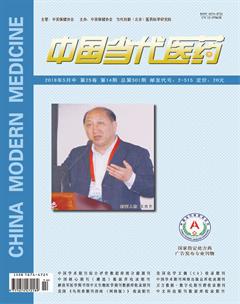妊娠合并糖尿病患者分娩结局及其与糖化血红蛋白的关系探讨
陈瑞妍
[摘要]目的 探討妊娠合并糖尿病患者糖化血红蛋白对其分娩结局的影响,为临床疾病治疗提供依据。方法 选取2014年9月~2017年9月在我院就诊的妊娠合并糖尿病患者90例作为观察组,另选取同期我院行健康产检的健康孕妇50例为对照组。按照观察组患者入院后血糖控制治疗1周后再次测量血糖分为血糖达标组(A组)和血糖未达标组(B组)。测量不同治疗阶段三组糖化血红蛋白水平,随诊产妇直至分娩,观察所有孕妇分娩结局,分析其与糖化血红蛋白含量的关系,并进行统计学分析。结果 观察组入院时糖化血红蛋白量明显高于对照组,差异有统计学意义(P<0.05)。观察组不良分娩结局发生率显著高于对照组,差异有统计学意义(P<0.05)。糖化血红蛋白含量≥6.5%患者不良分娩结局发生率显著高于糖化血红蛋白含量<6.5%患者,差异有统计学意义(P<0.05)。结论 高糖化血红蛋白与妊娠合并糖尿病患者不良分娩结局成正相关,孕期积极有效地监测并控制血糖可显著改善产妇分娩结局。
[关键词]妊娠;糖尿病;糖化血红蛋白;分娩结局
[中图分类号] R714.256 [文献标识码] A [文章编号] 1674-4721(2018)5(b)-0101-03
Relationship between the glycated hemoglobin levels and pregnancy outcome of pregnant women pregnancy associated with diabetes
CHEN Rui-yan
Department of Gynecology and Obstetrics,People′s Hospital of Fengkai County,Guangdong Province,Fengkai 526400,China
[Abstract]Objective To explore relationship between the glycosylated hemoglobin levels and pregnancy outcome of pregnant women pregnancy associated with diabetes and provide the basis for clinical treatment.Methods All of 90 cases of pregnant women pregnancy associated with diabetes from September 2014 to September 2017 treated in our hospital were observation group.Besides,50 pregnant women who were adopted healthy examination during the same period were selected as control group.After 1 week treatment in the observation gorup,the patients were divied group A and group B according to blood glucese normal or not normal.Measuring the different stages of observation group and control group in patients with glycosylated hemoglobin levels,follow-up until delivery,maternal observation all pregnant women delivery end,analyze its relationship with glycosylated hemoglobin content,and statistical analysis.Results The hemoglobin content of the patients in the observation group was significantly higher than that in the control group,the difference was statistically significant by statistical analysis (P<0.05).The incidence of adverse childbirth outcomes in the observation group was significantly higher than that in the control group,and statistically significant difference was found (P<0.05).The incidence of adverse childbirth outcomes was significantly higher in patients with glycated hemoglobin than that of 6.5% percent of the patients with glycated hemoglobin <6.5%,the difference was significant (P<0.05).Conclusion High glycosylated hemoglobin is positively correlated with the outcome of adverse childbirth outcomes in patients with gestational diabetes mellitus.Active and effective monitoring and control of blood glucose during pregnancy can significantly improve the outcome of maternal childbirth.
[Key words]Pregnancy;Diabetes;Glycated hemoglobin;Delivery outcome
妊娠合并糖尿病是临床妇产科最常見的产妇合并症之一,且多发生于高龄产妇,其发生率可达5%以上[1-2],近年来随着生活水平的提高,临床发病率有增高的趋势[3]。由于妊娠期机体的特殊及药物运用的限制,给临床治疗带来一定的难度[4]。研究表明孕期母体的高糖状态对母体及胎儿的健康影响与血糖控制程度密切相关[5],而对于孕前即使用胰岛素治疗的糖尿病患者妊娠期若不合理调整用量,极易造成妊娠期严重低血糖及糖尿病严重并发症的发生,进一步影响妊娠结局[6]。本研究探讨妊娠合并糖尿病对患者分娩结局的影响及其与母体糖化血红蛋白含量的关系,现报道如下。
1资料与方法
1.1一般资料
回顾性分析我院2014年9月~2017年9月收治的90例妊娠合并糖尿病患者作为观察组,另选取同期于我院行产前体检的正常妊娠孕妇50例作为对照组。按照观察组患者经入院后血糖控制治疗1周后血糖再次测定结果分为血糖达标组(A组)和血糖未达标组(B组)。纳入标准:①观察组妊娠前即已经临床确诊符合1999年WHO制定的糖尿病诊断标准[7];②所有患者妊娠均达24周以上,28周以下;③均为单胎妊娠;④均为首次妊娠;⑤入院前未接受任何降糖治疗。排除标准:①有明确原因的继发性糖尿病;②患者因其他原因无法耐受分娩手术者;③合并严重的周围组织或血管、神经损伤者;④合并心脑肾及神经系统等其他严重病患者。对照组年龄21~33岁,平均(26.3±1.6)岁;孕龄平均(25.3±1.4)周;A组40例患者,年龄22~33岁,平均(25.3±1.3)岁;平均孕龄(26.1±1.1)周;B组50例患者,年龄21~34岁,平均(27.1±1.4)岁;平均孕龄(26.6±1.6)周。三组患者在年龄、孕龄等一般资料比较,差异无统计学意义(P>0.05),具有可比性。本研究经患者同意并签署知情同意书,且经医院伦理委员会审批通过后开始实施。
1.2血红蛋白量检测方法
患者在入院后于第2天清晨抽取空腹静脉血5 ml,置于含有EDTA-K抗凝剂试管中,离心10 min后取血清采用SYSMEX全自动生化分析仪[型号:XN-20
1.3观察指标
检测两组入院时及入院经治疗后1周时的糖化血红蛋白含量,跟踪至孕妇分娩,记录患者分娩结局,包括羊水量、胎膜早破、宫内胎儿窘迫、早产与否及胎儿分娩时的体重等情况。
1.4不良分娩结局的判断标准[8]
早产是指确定妊娠至分娩时间为28~37周;羊水过多指分娩前行超声检查显示产妇腹部四象限羊水池综合深度在18 cm以上,或最大羊水池象限深度在8 cm以上;巨大儿是指新生儿体重达4000 g以上;胎儿宫内窘迫是指胎心监护中连续10 min胎心率出现180次/min以上或120次/min以下,且监护呈现出重度变异减速或持续存在的晚期减速。
1.5统计学方法
使用SPSS 17.0统计学软件对实验数据进行分析,计量资料以均数±标准差(x±s)表示,采用t检验;计数资料以率表示,采用χ2检验,以P<0.05为差异有统计学意义。
2结果
2.1三组患者糖化血红蛋白含量的比较
A、B两组入院时糖化血红蛋白量比较差异无统计学意义(P>0.05),但两组均显著高于对照组,差异有统计学意义(P<0.05)。入院1周后再次测量,A组与入院时及对照组比较,差异无统计学意义(P>0.05),B组与入院时及A组比较,差异有统计学意义(P<0.05)(表1)。
2.2三组患者不良分娩结局情况的比较
A组患者出现不良分娩结局发生率显著高于B组,差异有统计学意义(P<0.05)。B组不良分娩结局发生率显著高于对照组,A组发生率显著高于对照组,差异有统计学意义(P<0.05)(表2)。
2.3不同糖化血红蛋白含量患者不良分娩结局情况的比较
糖化血红蛋白含量≤6.5%的患者80例中不良分娩发生率显著低于糖化血红蛋白量>6.5%者,差异有统计学意义(P<0.05)(表3)。
3讨论
妊娠是妇女的特殊时期,机体在此期间多出现一系列不同于平常的生理变化,产妇自身的健康状态对分娩结局影响较大,因此孕前健康体检成为备孕者较为关注的中心[9]。随着人们生活水平和生活方式的改变,糖尿病的发生率愈来愈高,且发病年龄呈现愈发年轻的趋势,妊娠合并糖尿病亦成为临床妇产科常见的疾病之一[10]。研究表明[11-12],妊娠期,尤其是中后期妊娠患者机体出现胰岛素分泌不足,糖终末代谢产物所致机体应激反应强烈造成胰岛β细胞受损,使患者糖利用率进一步下降。
糖尿病使孕妇糖代谢进一步紊乱,易造成不良分娩结局的发生,其中早产儿的出现是糖尿病妊娠最常出现的并发症之一[13]。可能与糖尿病导致妊娠机体其他并发症产生而致医源性早产的出现有关[14]。本研究结果显示,糖尿病孕妇早产发生率显著高于正常产妇,差异有统计学意义(P<0.05)。早期诊断和及时监测是避免糖尿病患者妊娠不良分娩结局发生的关键,既往通过空腹血糖来评估糖尿病产妇的病情,但由于空腹血糖受是否进食、血液标本采集时间等诸多因素影响,波动性较大。糖化血红蛋白是血中游离葡萄糖醛基同血红蛋白B链氨基酸缩合作用形成的产物,其合成速度与血中游离葡萄糖的浓度成正比,由于其特定的代谢周期,糖化血红蛋白可用作反应过去1~2个月的平均血糖水平,因此可作为糖尿病较长时间血糖控制水平的较好监测指标[15-16]。
本研究结果显示,糖化血红蛋白含量越高,分娩不良结局的发生率越高,与正常妊娠孕妇比较,差异有统计学意义(P<0.05)。进一步研究发现,入院后经积极降糖治疗,部分孕妇糖化血红蛋白达正常水平,这部分患者分娩不良结局的发生率显著低于经治疗后血红蛋白仍未达标的患者,差异有统计学意义(P<0.05)。以糖化血红蛋白含量6.5%为界限分组,结果显示,高于6.5%的部分患者分娩结局要明显差于低于6.5%的患者,差异有统计学意义(P<0.05)。
综上所述,妊娠合并糖尿病患者分娩结局与糖化血红蛋白量密切相关,糖化血红蛋白量越高,分娩不良结局的发生率越高,积极监测并降低妊娠患者血糖有利于改善分娩结局,值得临床推广应用。
[参考文献]
[1]Amylidi S,Mosimann B,Stettler C,et al.First-trimester glycosylated hemoglobin in women at high risk for gestational diabetes[J].Acta Obstet Gynecol Scand,2016,95(1):93-97.
[2]Ryu AJ,Moon HJ,Na JO,et al.The usefulness of the glycosylated hemoglobin level for the diagnosis of gestational diabetes mellitus in the Korean Population[J].Diabetes Metab J,2015,39(6):507-511.
[3]马永萍,李娟,马小云.妊娠期糖尿病孕妇糖化血红蛋白水平与母婴结局的关系[J].现代妇产科进展,2016,25(2):127-130.
[4]Ayyappan S,Philips S,Kumar CK,et al.Serum fructosamine a better indicator than glycated hemoglobin for monitoring gestational diabetes mellitus[J].J Pharm Bioallied Sci,2015,7(Suppl 1):S32-S34.
[5]Khalafallah A,Phuah E,Albarazan AM,et al.Glycosylated haemoglobin for screening and diagnosis of gestational diabetes mellitus[J].BMJ Open,2016,6(4):235-242.
[6]Sugawara D,Maruyama A,Imanishi T,et al.Complications in infants of diabetic mothers related to glycated albumin and hemoglobin levels during pregnancy[J].Pediatr Neonatol,2016, 57(6):496-500.
[7]Quintero-Prado R,Bugatto F,Sánchez-Martín P,et al.The influence of placental perfusion on birthweight in women with gestational diabetes[J].J Matern-Fetal Neonatal Med,2016, 29(1):32-35.
[8]Zheng J,Cheng J,Zhang Q,et al.Association between glycosylated hemoglobin level and cardiovascular outcomes in diabetic patients after percutaneous coronary intervention[J].Medicine,2016,95(19):e3696.
[9]Ensenauer R,Brandlhuber L,Burgmann M,et al.Obese nondiabetic pregnancies and high maternal glycated hemoglobin at delivery as an indicator of offspring and maternal postpartum risk:the prospective peaches mother-child cohort[J].Clin Chem,2015,61(11):1381-1390.
[10]Shin D,Ahn J,Cha KS,et al.Impact of initial glycosylated hemoglobin level on cardiovascular outcomes in prediabetic patients with ST-segment elevation myocardial infarction undergoing primary percutaneous coronary intervention[J].Coron Artery Dis,2016,27(1):40-46.
[11]吴焘,张国秋.微创锁定加压钢板内固定改善老年肱骨近端骨折患者的肩关节功能:随机对照临床试验方案[J].中国组织工程研究,2016,20(44):6655-6660.
[12]Pimenta WP,Calderon IM P,Cruz NS,et al.Subclinical abnormalities of glucose metabolism in Brazilian women with a history of gestational diabetes mellitus[J].Acta Obstet Gynecol Scand,2004,83(12):1152-1158.
[13]林春晓,李春花,缪士霞,等.妊娠期糖尿病不同糖化血红蛋白水平的围产结局分析[J].实用医学杂志,2015,26(8):1268-1270.
[14]Fujimoto CY,Da CR,Zaccara TA,et al.Correlation of the levels of fructosamine and glycated hemoglobin with the blood glucose profile in pregnant women with diabetes mellitus[J].Rev Bras Ginecol Obstet,2016,38(1):20-26.
[15]Beyuo T,Obed SA,Adjepongyamoah KK,et al.Metformin versus insulin in the management of pre-gestational diabetes mellitus in pregnancy and gestational diabetes mellitus at the Korle Bu teaching hospital:a randomized clinical trial[J].PLoS One,2015,10(5):e0125712.
[16]Jovanovic L,Gutierrez M,Peterson CM.Chromium supplementation for women with gestational diabetes mellitus[J].J Trace Elem Exp Med,2015,12(2):91-97.
(收稿日期:2018-03-01 本文編辑:崔建中)

